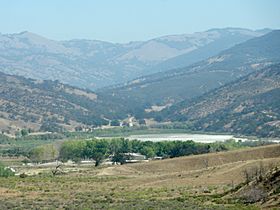Castac Lake facts for kids
Quick facts for kids Castac Lake |
|
|---|---|

Castac Lake is visible from I-5.
|
|
| Location | Lebec, Kern County, California |
| Coordinates | 34°50′06″N 118°50′35″W / 34.8349730°N 118.8431683°W |
| Type | saline, endorheic |
| Primary inflows | Cuddy Creek, Bear Canyon, Crane Canyon |
| Primary outflows | Grapevine Creek |
| Catchment area | 56 sq mi (150 km2) |
| Max. length | 1 mile (1.6 km) |
| Surface area | 400 acres (160 ha) |
| Surface elevation | 3,484 ft (1,062 m) |
Castac Lake, also known as Tejon Lake, is a natural salt lake in California. It is located near Lebec, within the Tehachapi Mountains. You can see it just south of the Grapevine section of Interstate 5. The lake is part of the large Tejon Ranch. Its normal water level is about 3,482 feet (1,061 m) above sea level.
Contents
How Castac Lake Was Formed
Castac Lake sits in a natural dip in the land called Castac Valley. This valley was formed by a big crack in the Earth's crust called the Garlock Fault. Water flows into the lake mainly from Cuddy Creek and smaller streams from Bear and Crane Canyons. These streams drain an area of about 56 square miles (150 km2).
The lake itself formed around 10,000 years ago. This happened when a natural dam of dirt and rocks, called an alluvial fan, blocked Cuddy Creek's path. This blockage stopped the water from flowing north into Grapevine Creek. Usually, the lake's surface is lower than its outlet to Grapevine Creek. But during very heavy rains, the lake can overflow into Grapevine Creek, which then flows into the San Joaquin Valley.
Who Lived Near Castac Lake?
Even though Castac Lake is salty, many freshwater springs nearby made it a great place for people to live. The area around the lake was once home to the Castac and Emigdiano groups of Chumash people. They lived between Tejon Pass and the modern Grapevine area. Several Native American villages were located here. One Emigdiano village, called Sasau, was on the northern shore of the lake.
The Chumash people had their own names for the lake. In their language, Kash-tük meant "my eyes." In the Kitanemuk language, it was called A-uva-pya, meaning "in his eyes." The Yokuts people called it Sasa-u, which meant "at the eye."
Exploring Castac Lake's Past
The first European to see Castac Lake was a Spanish explorer named Pedro Fages. In 1772, he led the first European group to cross the Tehachapi Mountains through Tejon Pass. Fages named the lake Salinas de Cortes. The lake's current name might come from a later Spanish trip around 1806. During this trip, Father José María de Zalvidea noted a Native American village called "Casteque" or "Kashtiq" near a "pure salt water" lake.
In 1843, the lake became part of a large land grant called Rancho Castac, which was about 22,178 acres (8,975 ha). Later, in 1854, Fort Tejon was built about 5 miles (8.0 km) northwest of the lake. This fort helped control the main travel route between Central California and Southern California. Eventually, Edward Fitzgerald Beale bought Rancho Castac and created Tejon Ranch. At one point, Tejon Ranch was the biggest private landholding in California.
Lake Levels and Salt Mining
In the late 1800s and early 1900s, people sometimes mined salt from the lakebed. This happened when the lake dried up during long periods without rain. Historical records show the lake was full for most of the 1940s. However, it was dry in the early 1950s and early 1980s. In the mid-1990s, especially after the El Niño event in 1997, the lake filled up so much that it overflowed.
Since 2001, Tejon Ranch has been pumping groundwater to keep the lake level high. This practice has caused some debate because the well water levels in the area have been dropping. Higher lake levels also increase the chance of the lake overflowing and causing floods in Grapevine Valley, as happened in 2005.
Water Quality of Castac Lake
Because of the natural rock and soil in the area, Castac Lake naturally has higher levels of certain elements. These include arsenic, boron, selenium, and aluminum. During dry periods, these elements become more concentrated in the lake water. When floods occur, they help flush out these elements.



